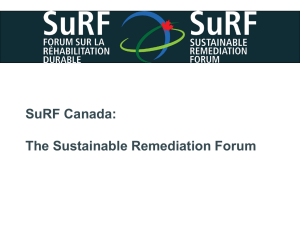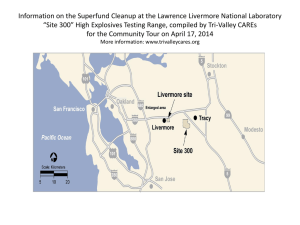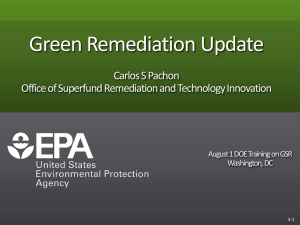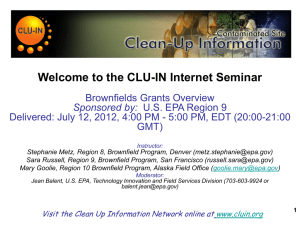continued - CLU-IN
advertisement
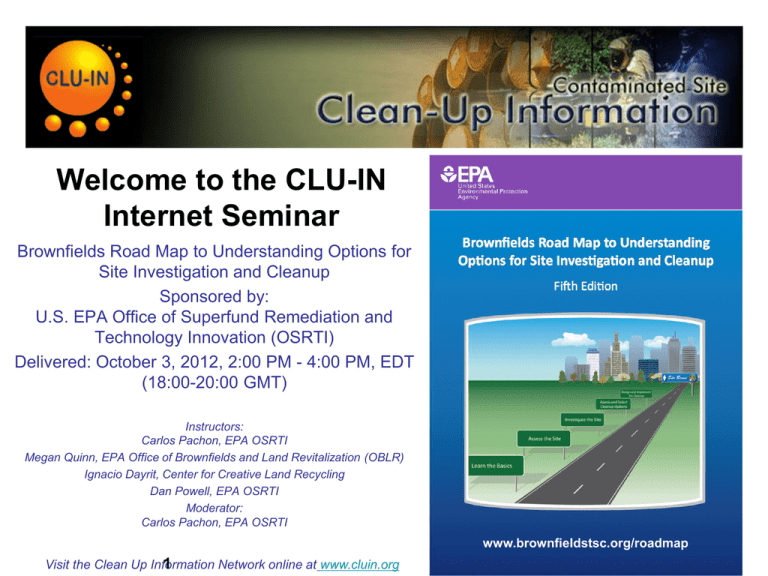
Welcome to the CLU-IN Internet Seminar Brownfields Road Map to Understanding Options for Site Investigation and Cleanup Sponsored by: U.S. EPA Office of Superfund Remediation and Technology Innovation (OSRTI) Delivered: October 3, 2012, 2:00 PM - 4:00 PM, EDT (18:00-20:00 GMT) Instructors: Carlos Pachon, EPA OSRTI Megan Quinn, EPA Office of Brownfields and Land Revitalization (OBLR) Ignacio Dayrit, Center for Creative Land Recycling Dan Powell, EPA OSRTI Moderator: Carlos Pachon, EPA OSRTI www.brownfieldstsc.org/roadmap 1 Visit the Clean Up Information Network online at www.cluin.org Housekeeping • Please mute your phone lines, Do NOT put this call on hold – press *6 to mute #6 to unmute your lines at anytime • Q&A • Turn off any pop-up blockers • Move through slides using # links on left or buttons Download slides as PPT or PDF Go to slide 1 Move back 1 slide Move forward 1 slide Go to last slide Go to seminar homepage Submit comment or question Report technical problems • This event is being recorded • Archives accessed for free http://cluin.org/live/archive/ 2 Welcome Introductions Review of Agenda Topic Presenter Relevance for EPA Grant Recipients and Applicants Megan Quinn, EPA Overview of the Road Map Carlos Pachon, EPA Discussion of Core Chapters Ignacio Dayrit, CCLR A Closer Look at Spotlights Dan Powell, EPA Questions and Answers Carlos Pachon, EPA Wrap-up Carlos Pachon, EPA 3 Relevance for EPA Grant Recipients and Applicants The Road Map may be helpful for those receiving or applying for EPA funding or technical assistance Background information, activities and considerations are presented about several EPA programs, including: Assessment Grants Cleanup Grants Targeted Brownfields Assessments State and Tribal Response Programs Learn more about EPA grants for brownfields at www.epa.gov/brownfields/grant_info 4 Resources for EPA Grant Recipients and Applicants The FY13 Assessment, RLF and Cleanup Grant Guidelines are posted at www.epa.gov/brownfields/applicat.htm Proposals are due November 19, 2012 The FY13 Area-Wide Planning Grant Guidelines are posted at www.epa.gov/brownfields/applicat.htm Proposals are due November 30, 2012 The National Brownfields Conference is May 15-17, 2013 in Atlanta, Georgia (www.brownfieldsconference.org) 5 Target Audiences New and less experienced stakeholders Decision-makers looking for detailed information Community members Stakeholders who hire or oversee site cleanup professionals Regulators Other stakeholders, including financial institutions and insurance agencies 6 Fifth Edition – Back to Basics Theme Helps non-technical stakeholders understand the process of assessing and cleaning up brownfields sites Focuses on concepts, strategies and methods to prepare sites for reuse Introduces a range of considerations and activities for each phase of a brownfields project Uses independent “spotlights” to provide an overview of specific technical and policy issues, best practices and innovative approaches to site assessment and cleanup 7 Fifth Edition – New Format 8 New Section – Learn the Basics Setting reuse goals and planning Understanding regulations, regulatory guidelines and liability concerns Engaging the community Identifying funding Seeking professional support Spotlights EPA’s redevelopment initiatives to more efficiently and collaboratively prepare contaminated properties for reuse Spotlights EPA’s efforts to support tribal revitalization 9 Highlights of the Road Map Website Online version of publication Links to technical resources Approximately 300 available resources Listed within each section Searchable by title Options to preview and download Spotlight issues Provides quick look at relevant topics Can be updated with new issues as they emerge “Clickable” Road Map 10 Online Guide to Contaminants and Technologies Presents the range of technologies for investigating and remediating contaminants found at typical brownfields sites Provides navigation options to help users find details based on what is currently known about their site Find information about specific site types Identify which contaminant groups are likely to be found Learn about technologies used to investigate and treat contaminants likely to be found Links to related publications and resources 11 Online Guide to Contaminants and Technologies – EXAMPLE My brownfields project involves property once used for dry cleaning operations What types of contaminants are typically found on dry cleaner sites? What technologies can be used to effectively investigate my site? What technologies are available for treating contamination on my site? Where can I find more information? Start with the site type Summary matrix shows that halogenated and nonhalogenated volatile organic compounds (VOCs) are typically found Click the site type for more information Dry cleaning 12 Online Guide to Contaminants and Technologies – EXAMPLE Read more about the contaminants Learn about investigation and treatment technologies used for those contaminants Click on a technology to learn more Treatment technology: Air sparging 13 Online Guide to Contaminants and Technologies – EXAMPLE Description of the technology is provided Links to more information and resources are available from the “Get More Information” tab 14 Brownfields and Technical Support Contacts Links to contacts at the state and EPA national and regional levels who are available to assist cleanup and redevelopment efforts at brownfields sites Contacts are a valuable resource for support and guidance Applicable laws Regulations Policies May be able to offer technical assistance associated with the selection of technologies 15 16 Core Road Map Chapters Each chapter expands and updates content from the previous edition of the Brownfields Road Map General information about the phase is provided Typical activities conducted during the phase are listed Questions to be considered during each phase are highlighted Possible outcomes of the phase and next steps are explained 17 Assess the Site ? Has the site condition been evaluated through a site investigation? Is there evidence of possible contamination? The site assessment is crucial for determining further environmental investigation and cleanup steps Typically begins with an ASTM International Phase I Environmental Site Assessment (ESA) Includes the conduct of an All Appropriate Inquiries (AAI) investigation Information collected during the site assessment provides early indications for the cleanup requirements associated with the intended reuse of the site Information is typically organized into a project life cycle conceptual site model (CSM) 18 Assess the Site (continued) Typical activities conducted during the site assessment phase: Establishing a core project team including technical experts Identifying future plans for reuse Exploring options for funding and technical assistance Conducting the ASTM International Phase I ESA (or equivalent) Developing the CSM Reviewing government oversight programs Reaching out and encouraging community participation Many questions should be considered during this phase Project goals and planning (e.g., has a redevelopment plan been prepared?) Oversight (e.g., will the site be entered into a voluntary cleanup program?) Community (e.g., how can meaningful community involvement be solicited?) Site conditions (e.g., what is known about the site?) Funding (e.g., who will pay for the site investigation and cleanup?) 19 Assess the Site (continued) The Road Map connects information collected while assessing the sites to later phases of the project Determining the scope of the site investigation Understanding data quality considerations Aligning cleanup requirements to the intended reuse Sharing information with the local community Key questions are highlighted Project goals and planning Oversight Community Site conditions Funding 20 Assess the Site (continued) Possible courses of action based on the results of the site assessment are outlined More than 40 helpful resources associated with site assessments are linked from the Road Map website Spotlight topics All Appropriate Inquiries Project Life Cycle CSM 21 Investigate the Site ? Was contamination found? Is there an immediate threat to local residents? Can redevelopment and reuse occur without cleanup? The site investigation confirms contamination and identifies its source, nature and extent Also referred to as a Phase II ESA May include baseline risk assessments Results are used to support project decisions, set cleanup goals, assess anticipated cleanup costs and evaluate the economic viability of the project Available technologies improve site investigation results Best management practices (BMPs) have emerged to incorporate systematic project planning, dynamic work strategies and the use of real-time measurement technologies 22 Investigate the Site (continued) The site investigation phase typically involves: Exploring the potential for obtaining EPA grant funding or technical assistance Inviting community members to participate in discussions Researching available technologies and methods to conduct the site investigation Conducting a Phase II ESA Performing a risk assessment Evaluating potential cleanup costs and constraints Updating the project life cycle CSM and sharing with stakeholders Project teams should consider many questions, including several related to options for the site investigation: Has the full range of available technologies been explored? What real-time technologies are available to facilitate site investigation and support data collection efforts? Can the technologies selected reduce the number of mobilizations to the site? Will the site investigation involve iterative steps to address data gaps? 23 Investigate the Site (continued) Helping stakeholders understand the true conditions of their sites Introduction to different types of uncertainty Description of technologies that produce real-time results to supplement laboratory analysis Best management practices for linking decisions, data and technologies Types of Uncertainty Using BMPs helps to reduce a variety of uncertainties associated with brownfields projects. Analytical Uncertainty Methods, Quantity, Quality, Validation, Appropriate Use Sampling Uncertainty Media, Methods, Location, Distribution, Depth, Purpose Site Decision Uncertainty Risk, Action Levels, Remedy, Stakeholders, Acceptability Resource Uncertainty Funding, Schedule, Personnel, Logistics, Weather 24 Investigate the Site (continued) Possible courses of action based on the results of the site investigation are presented Includes potential for conducting additional site investigation as more information is known about the site More than 75 helpful resources associated with site investigation are linked from the Road Map website Spotlight topics Data Quality: The Key to Making Robust Site Decisions High Resolution Site Characterization and In Situ Technologies Vapor Intrusion 25 Assess and Select Cleanup Options ? Can risks be managed adequately in light of the proposed reuse? Can the project occur given the cleanup options? Is there a practical redevelopment or reuse alternative? Data and information known about a property are used to review and evaluate cleanup options applicable to specific site conditions and consistent with cleanup and reuse goals Involvement of the affected community contributes significantly to long-term acceptance and support of the selected cleanup alternative and the overall reuse goals It is important to frame discussions and decisions around budget considerations and schedule constraints so that the project remains financially viable 26 Assess and Select Cleanup Options (continued) Helping stakeholders select the best options Establishing cleanup objectives that consider the end use Communicating information about the proposed cleanup option to brownfields stakeholders, including members of the affected community Identifying cleanup technologies and approaches that have a proven track record for sites with similar contaminants and conditions Enlisting the help of a professional environmental practitioner with experience in applying these technologies at similar sites Assessing the use of institutional controls (IC) as part of the cleanup approach Collaborating with regulatory agency stakeholders to ensure that regulatory requirements are properly addressed Recognizing and coping with challenging cleanups 27 Assess and Select Cleanup Options (continued) Questions to be considered to assist stakeholders with assessing options Are cleanup options compatible with regional or local planning goals and requirements? How long will the cleanup take? What will the cleanup cost? Who will pay for long-term costs to maintain the cleanup, including any ICs? More than 90 helpful resources for assessing and selecting cleanup options are linked from the Road Map website Spotlight topics Challenging Cleanups Understanding the Role of ICs at Brownfields Sites 28 Design and Implement the Cleanup ? Was the contamination adequately removed, contained or controlled? Has contamination been discovered that requires more investigation? The property is prepared for redevelopment and reuse by carrying out the selected cleanup options The design of the cleanup plan and implementation of the chosen remedies involves close coordination with all other redevelopment efforts in the immediate vicinity of the site Maintaining stakeholder participation during cleanup promotes long-term community acceptance and support 29 Design and Implement the Cleanup (continued) Typical activities conducted during this phase include: Reviewing applicable federal, state, local and tribal regulations and guidelines Developing conceptual cleanup and monitoring plans Establishing contingency plans to address the discovery of additional contamination during cleanup, including tools such as environmental insurance Conducting public outreach meetings on a regular basis Providing updates about the progress of cleanup activity Sharing successes when important cleanup milestones are achieved Informing the community about changes in activity that could affect reuse plans Monitoring the performance of the cleanup Working with the state voluntary cleanup program (VCP), if applicable, and county or local officials to facilitate the placement and implementation of institutional controls Implementing the cleanup may lead to the discovery of additional contamination, requiring further site investigation and characterization 30 Design and Implement the Cleanup (continued) The Road Map presents cleanup plans and activities in the context of available options Options may evolve during a project as site conditions are understood Real-time technologies and BMPs used to investigate the site also help to evaluate the results of the cleanup Sometimes, additional investigation is required Examples of questions to be considered Are there federal, state, local and tribal requirements for the design, installation and monitoring of cleanup activities? Can redevelopment and cleanup activities be performed concurrently? How will the cleanup design affect long-term liabilities or future use of the site? How will long-term monitoring be funded and managed? 31 Design and Implement the Cleanup (continued) Possible courses of action based on the results of the cleanup If contamination has been adequately removed, contained or controlled, consult with the appropriate regulatory officials before proceeding with redevelopment activities If additional contamination has been discovered, consult with the appropriate regulatory officials to determine next steps Conduct additional sampling to delineate the extent and nature of the contamination and to assess the overall viability of the project Collect after-performance samples for monitoring the cleanup More than 100 helpful resources for designing and implementing cleanups are linked from the Road Map website Spotlight topics Greener Cleanups 32 Spotlights: Opportunities & Challenges Project Life Cycle CSM Vapor Intrusion Challenging Cleanups Understanding the Role of Institutional Controls at Brownfields Sites Road Map Spotlights • All Appropriate Inquiries • Challenging Cleanups • Data Quality: The Key to Making Robust Site Decisions • Greener Cleanups • High-Resolution Site Characterization and In Situ Technologies • Project Life Cycle CSM • Redevelopment Initiatives: Connecting Cleanup and Reuse • Supporting Tribal Revitalization • Understanding the Role of ICs at Brownfields Sites • Vapor Intrusion 33 Project Life Cycle CSM A CSM is a graphical and written summary of what is known or hypothesized about environmental contamination at a site CSMs assist stakeholders to: More fully understand site conditions and features Synthesize information from multiple sources Identify which information is unknown or uncertain about the site Define a plan for collecting additional information Obtain stakeholder agreement on site conditions and related project investigation, design and cleanup plans Triad Resource Center website (www.triadcentral.org) Tools for developing and using a CSM Examples of CSMs 34 Project Life Cycle CSM (continued) The CSM evolves through all stages of site redevelopment and becomes a tool to support technical and communication needs 35 Vapor Intrusion Vapor Intrusion (VI) occurs when toxic vapors enter structures, become concentrated and contaminate the indoor air Sources include chemicals in contaminated soil or groundwater Vapor-causing contaminants are commonly referred to as volatile organic compounds (VOCs) Examples of VOCs include gasoline, degreasers, dry-cleaning solvents, naphthalene and some pesticides VI is also caused by semivolatile organic compounds (SVOC) VI should be evaluated for all brownfields projects with possible VOC contamination in the subsurface of the site property or in the subsurface of nearby property 36 Vapor Intrusion (continued) Evaluating the potential for VI should begin early in the site assessment and investigation phases The movement of volatile vapors can be difficult to quantify – appropriate sampling should be conducted during the site investigation to evaluate potential exposure pathways Concerns should be incorporated into the project life cycle CSM Operation, maintenance and monitoring of mitigation systems are generally necessary Some states have specific VI guidance – environmental agencies should be consulted to ensure that up-to-date and appropriate guidance is followed 37 Vapor Intrusion (continued) Strategies to reduce or eliminate indoor air contaminant risks may include (but are not limited to): Remediating or controlling the sources of contamination in the subsurface Increasing natural building ventilation Ventilating the affected buildings with properly operated heating, ventilation and air conditioning systems Restricting the use of the facilities of concern Changing the location or altering the design of future buildings Key resources available on the Road Map Website Brownfields Technology Primer: Vapor Intrusion Considerations for Redevelopment provides a detailed introduction to VI and summarizes techniques for assessment and mitigation EPA’s VI website: www.epa.gov/oswer/vaporintrusion/ CLU-IN website issues – Vapor Intrusion: www.clu-in.org/issues/default.focus/sec/Vapor_Intrusion/ 38 Challenging Cleanups Some brownfields properties are contaminated with chemicals that are highly mobile, hard to find or difficult to treat Contaminants are difficult to capture or separate Contamination is located in hard-to-reach areas (for example, fractured bedrock) Contaminants do not degrade naturally in the environment Challenging cleanups affect a variety of site types Contaminant concentrations and properties affect project planning An accurate characterization of the site and a solid understanding of contaminant behavior in the environment is critical CLU-IN Contaminant Focus (www.cluin.org/contaminantfocus) 39 Challenging Cleanups (continued) EXAMPLE: Dense Non-Aqueous Phase Liquids (DNAPLs) Do not easily dissolve in water (only slightly soluble) Tend to sink through groundwater and permeate into fine-grained soil units such as silt and clay Migrate in multiple directions Act as continuing sources of contamination Traditional cleanup systems (pump and treat) may require years A variety of effective strategies, including combining several options, exist for challenging cleanups: Treatment of the source area Treatment of the dissolved plume Containment of the plume or polishing agents Institutional controls 40 Understanding the Role of ICs ICs are a broad spectrum of administrative and legal tools Minimize the potential for exposure to residual contamination Restrict land use activities to protect physical cleanup measures Provide information that helps modify or guide human behavior at a site Normally supplement engineered controls Typically used in conjunction with the overall cleanup remedy to support reuse 41 Understanding the Role of ICs (continued) Long-Term Considerations Long-term costs and administrative implications of maintaining and enforcing ICs Planning for implementation, maintenance and enforcement challenges Comparison of the costs of leaving contamination in place while maintaining ICs to the costs associated with treating or removing contamination Key resources available on the Road Map Website EPA fact sheet: “An Introduction to the Cost of Engineering and Institutional Controls at Brownfield Properties” www.epa.gov/brownfields/tools/lts_cost_fs.pdf EPA fact sheet: “Addressing Long-Term Stewardship: Highlights from the Field” (highlights long-term considerations for maintaining and enforcing ICs) www.epa.gov/brownfields/tools/lts_fs_04_2008.pdf 42 Questions & Answers 43 Wrap-up The Brownfields Road Map is available online at: www.brownfieldstsc.org/roadmap This webinar will be available for future viewing at www.cluin.org/live/archive Visit the BTSC at www.brownfieldstsc.org EPA’s Office of Solid Waste and Emergency Response (OSWER) is building the technical capacity of small and disadvantaged businesses – learn more at http://cluin.org/smallbusiness/ Coming soon……. Brownfields Grantees’ Road Map to Understanding Quality Assurance Project Plans Leveraging Contracts for Innovative Site Characterization and Cleanup: Contracting Primer and Administrative Toolkit 44 Resources & Feedback • To view a complete list of resources for this seminar, please visit the Additional Resources • Please complete the Feedback Form to help ensure events like this are offered in the future Need confirmation of your participation today? Fill out the feedback form and check box for confirmation email. 45 New Ways to stay connected! • Follow CLU-IN on Facebook, LinkedIn, or Twitter https://www.facebook.com/EPACleanUpTech https://twitter.com/#!/EPACleanUpTech http://www.linkedin.com/groups/Clean-UpInformation-Network-CLUIN-4405740 46
